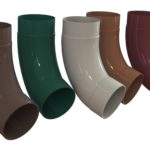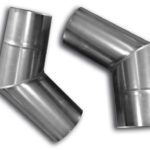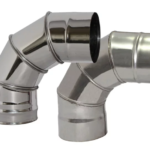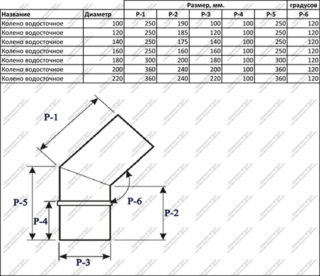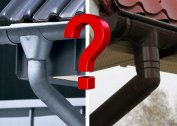An elbow of a drainpipe is a part bent at the required angle. The bypass is used in almost all gutters in order to successfully combine a drainage system and a funnel collecting precipitation, bypass architectural obstacles and protect the foundation.
Product purpose
The knee looks like a short pipe bent at an angle of 45, 60 or 90 degrees. An element has several important functions:
- The vertical part of the drainage system is fixed as close to the wall as possible - at a distance of 3-5 cm. But the funnel for collecting water lags the vertical by a greater distance. You can connect them only with a pair of knees.
- The buildings are equipped with cornices, bay windows, columns and other elements of architecture. Assembly of direct gutters is not possible. In the most difficult cases, up to six knees are used.
- The knee piece helps organize drainage. If fluid flows directly from the gutter, it spills directly onto the blind area and can damage the wall and foundation. To increase the distance, a contour of the desired length is placed on the lower part of the sewer.
Sometimes marks are used for decorative purposes to create a proportional composition. They are made in contrasting colors compared to the main system.
Types of Elements
Details are divided according to configuration and material. For the manufacture of bypass elements are mainly used:
- steel alloys that are pre-galvanized;
- stainless steel
- polymeric materials, most often PVC.
- Polymer
- Galvanized steel
- Stainless steel
The latter option is distinguished by the budget cost and moisture resistance. However, polyvinyl chloride cannot boast of increased strength and with a rough installation or direct impact it can burst.
Galvanized steel marks are more durable. They are also lightweight and easy to install, but they make a lot of noise during bad weather and can rust over time if the galvanizing layer is damaged.
Stainless steel options are the most durable. But such systems are quite expensive.
There are combined options for drainage systems. For example, if the main body of the drain is made of galvanized steel and coated with polymer. Metal and PVC parts are also combined in one system. For example, a galvanized funnel can be connected with a bend to a drain plastic pipe.
Bypass parts can corrugate. This gives the product flexibility - it can be adapted to any architectural features of the building. In rigid models, the angle is always unchanged. They are more durable and less clogged.
The quality requirements for any kind of elbows are very high. Joints are most vulnerable due to abutment seams. In these places, the system begins to collapse.
Product Dimensions
The length of the mark usually does not exceed 35 cm on each side. If the distance between the cornice and the wall is greater, the bypass parts of a suitable bend are joined using an additional pipe section. So they achieve the joining of elements even in the most inconvenient places.
The smaller the elevation angle, the more freely the water passes through the drain. On steep bends, trash often accumulates. Therefore, rectangular products try to apply as little as possible.
The size of the desired segment is equal to the distance between the cornice and the wall at the desired angle, taking into account the dimensions of the gutter and drainage.
The cross-section of a galvanized or polymeric elbow of the drainpipe is standard - from 10 cm and above. If the system is made to order, then the connecting parts are customized to the required dimensions. This also applies to the sizes of plastic and metal gutters.
Mounting Features
The installation of products made of polymers and metal differs at the stage of connection to the water intake. The plastic bypass part of the pipe is mounted using a rubber seal. It is necessary to create an airtight pipeline. The sealing ring is fixed using special glue.
The steel branch is put on a water intake funnel and secured with a special clamp. The method of docking with the drainage section depends on the type of the latter.
Further assembly is identical for products from any materials. A gutter located in a vertical plane connects to the second elbow and is secured with clamps. After the installation of the system is carried out using coupling connectors.
The cost of the part is small. It ranges from 100 to 500 rubles, depending on the material. It is more profitable to purchase them from manufacturers or in the kit of the entire drain.
When choosing metal products, focus on the reliability of the seam fastening of the joint, which is primarily subjected to stresses in the entire drainage system and often breaks it. Most often this happens in winter and spring, when a large amount of precipitation melts ice and snow on the roof, but negative temperatures remain on the street.

